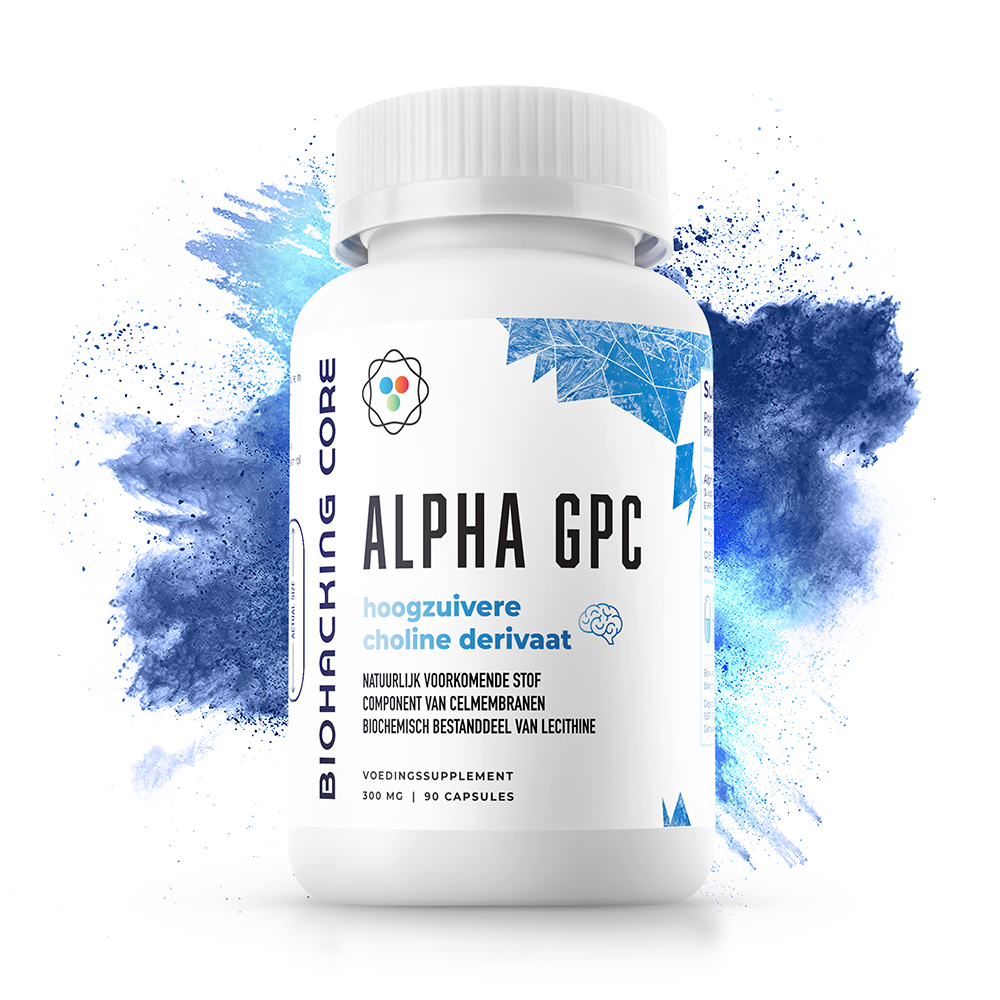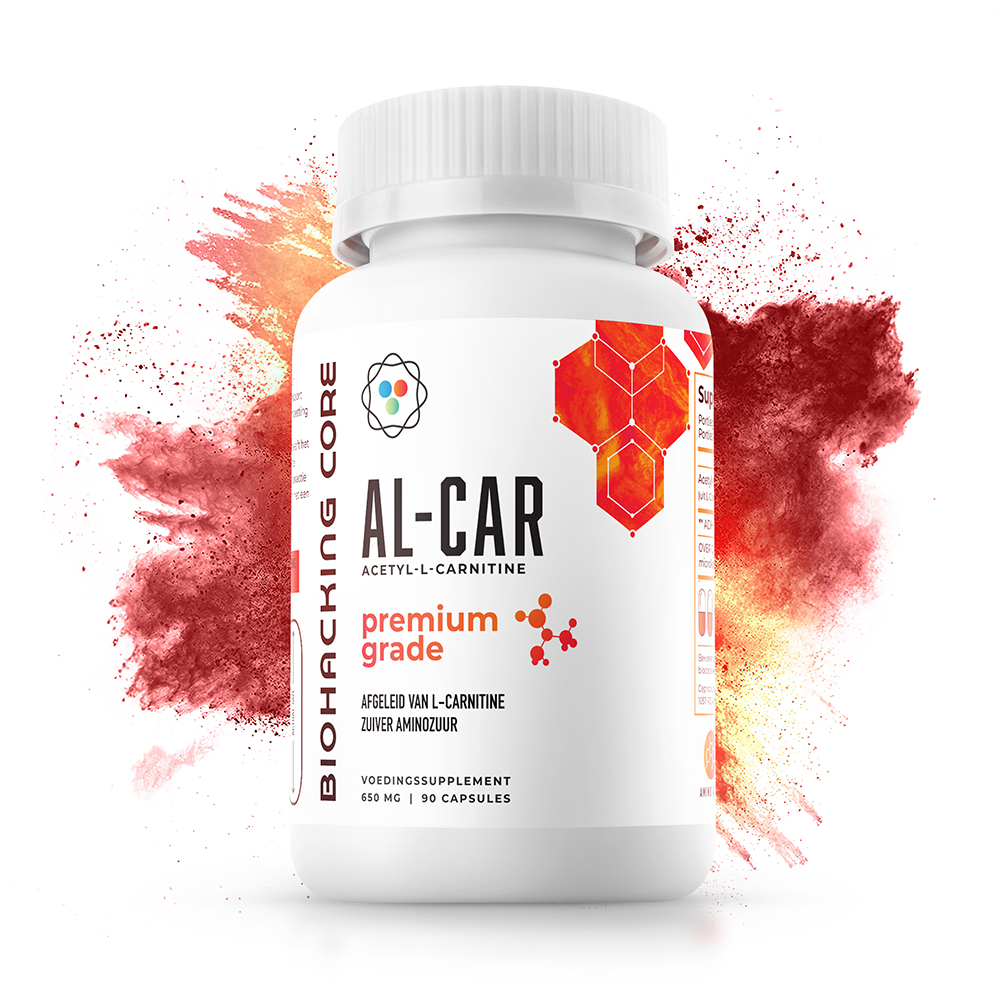

Alpha GPC
- Category: Nootropics
Quantity
| Quantity | Discounted price | DISCOUNT |
|---|---|---|
| 3-5 | €24.65 | 5%€1.30 |
| 6-9 | €23.87 | 8%€2.08 |
| 10+ | €23.35 | 10%€2.60 |
Change your country
- Your Biohacking Experts.
- Mo-Fr Same day shipping for orders before 17:00.
- Free shipping for orders above 75eu.
- Superior Quality high purity extracts and compunds.
- Quantity based discounts applicable.
Frequently Bought Together:
Biohacking Core Alpha GPC 300mg Capsules
Product Overview
Biohacking Core Alpha GPC provides L-alpha-glycerylphosphorylcholine, a readily absorbed choline compound, in convenient capsule form. Alpha-GPC is naturally present in the body and trace amounts are found in certain foods. This supplement offers a reliable way to incorporate Alpha-GPC into your daily regimen.
Once absorbed, Alpha GPC provides choline. Choline is a precursor to the neurotransmitter acetylcholine and is also involved in the synthesis of phospholipids like phosphatidylcholine, which are components of cell membranes.
Key Features
- Provides 300 mg of Alpha GPC per capsule.
- Highly bioavailable source of choline.
- Involved in phospholipid synthesis.
- Precursor to acetylcholine.
- Convenient capsule format.
- Suitable for daily supplementation.
Ingredients & Supplement Facts
- Serving Size: 2 capsules
- Servings Per Container: 45
- Amount Per Serving:
- Alpha GPC (L-alpha-glycerylphosphorylcholine): 600 mg (providing approx. 240 mg Choline)
- Other Ingredients: Cellulose (capsule shell), Microcrystalline Cellulose, Magnesium Stearate.
Suggested Use
Take 2 capsules daily (one serving), preferably in the morning, or as advised by a healthcare professional. Swallow capsules with water.
Quality & Purity Assurance
Biohacking Core is committed to providing high-quality supplements. Our Alpha GPC is sourced carefully and manufactured according to stringent standards to ensure consistency and purity. Quality control procedures are implemented during production..
Packaging & Storage
- Packaging: 90 capsules per plastic bottle, sealed for freshness.
- Storage: Store in a cool, dry place below 25°C. Keep the bottle tightly closed to protect from moisture, as Alpha GPC is hygroscopic. Do not freeze. Keep out of reach of children.
Warnings & Cautions
- For adult use only. Not recommended for individuals under 18 years of age.
- Consult your healthcare provider before using this product if you are pregnant, breastfeeding, have a pre-existing medical condition, or are taking any medications.
- Discontinue use and consult your doctor if any adverse reactions occur.
- Do not use if the safety seal is broken or missing.
Disclaimer
This product is a dietary supplement and is not intended to diagnose, treat, cure, or prevent any disease. It should not be used as a substitute for a varied and balanced diet or a healthy lifestyle. Do not exceed the recommended daily dose.
Ingredient Overview
Alpha-GPC (L-α-glycerylphosphorylcholine, also known as choline alfoscerate) is a naturally occurring choline compound found in the human body and in small amounts in common foods8. Chemically, it is a phospholipid metabolite – essentially a deacylated form of phosphatidylcholine – that can release free choline. Alpha-GPC is used as a dietary supplement ingredient, primarily as a concentrated source of choline (an essential nutrient) in functional foods and supplements. It has also been utilized in clinical settings (particularly in some European and Asian countries) as a prescription nutrient for neurological conditions, although in most countries it is available as an over-the-counter supplement rather than a drug8. Importantly, alpha-GPC is not marketed with any disease treatment claims in the EU; it is introduced as a novel food ingredient to fortify diets with bioavailable choline in a neutral, nutritional context.
Chemical Classification and Structure
Alpha-GPC belongs to the class of cholinergic phospholipid derivatives. Structurally, it is the sn-glycero-3-phosphocholine backbone of lecithin (phosphatidylcholine) with both fatty acid groups removed8. In other words, the molecule consists of a glycerol backbone with two free hydroxyl groups and a phosphate esterified to choline8. Its molecular formula is C8H20NO6P, giving a molar mass of about 257.2 g/mol8. The IUPAC name reflects its structure: (2,3-dihydroxypropyl) 2-(trimethylazaniumyl)ethyl phosphate, indicating the glycerol (propane-1,2,3-triol) framework attached to a phosphorylcholine moiety. The naturally occurring form is the L-α stereoisomer (sometimes denoted sn-3-glycerophosphocholine), which is the same configuration produced from biological phospholipids. Alpha-GPC is highly soluble in water and hygroscopic. In pure form it is typically a white, crystalline or amorphous powder that readily absorbs moisture from air8. Commercially, it is often sold either as a 100% pure powder (assay ≥98% alpha-GPC) or as a concentrated aqueous solution (around 85% alpha-GPC in water)8. These forms are chemically identical in active substance, differing only in water content. Alpha-GPC is stable under normal storage conditions but may degrade if exposed to extreme heat or prolonged humidity, owing to its hygroscopic nature. As a choline ester of glycerol phosphate, it forms an internal zwitterion (positively charged choline head and negatively charged phosphate group) and has no net charge; it is sometimes described as a “semi-synthetic” water-soluble phospholipid because it is derived from natural lecithin components by removing fatty acids.
Dietary Sources
Although alpha-GPC is not commonly referred to in food composition tables, it is naturally present in the diet in trace amounts. Being a component of lecithin, alpha-GPC occurs in foods that contain phosphatidylcholine or related phospholipids. Notably, human breast milk contains alpha-GPC as part of its choline content. Cow’s milk and other dairy products also provide small quantities. For example, one analysis reported about 9–10 mg of alpha-GPC per 100 g in cow’s milk and yogurt. Egg yolks (rich in lecithin) predominantly yield phosphatidylcholine and free choline, but minor amounts of glycerophosphocholine can be present after digestion. Certain meats and organ tissues that store phospholipids may contribute small amounts as well. Seafood has been identified as a dietary source: some fish, especially if dried or cured, have relatively higher alpha-GPC content. In one dataset, dried steelhead trout flesh contained approximately 190 mg of GPC per 100 g, smoked salmon around 130 mg/100 g, and raw salmon on the order of 40–50 mg/100 g. By contrast, most plant-derived foods contain very little alpha-GPC unless lecithin is added during processing. Some processed foods (like chocolate or baked goods) may incidentally contain a few milligrams of alpha-GPC per serving due to added soy lecithin emulsifiers. Overall, a normal mixed diet is estimated to provide only minimal amounts of pre-formed alpha-GPC; the majority of dietary choline comes in other forms (such as phosphatidylcholine, free choline, and betaine). The small quantities of alpha-GPC that are present in foods have always been part of the human diet without noted adverse effects, but they are nutritionally minor. This is why alpha-GPC is considered for use as a supplement – to deliver a useful dose of choline in a compact form beyond what is obtained from food alone.
Biochemical Role and Presence in the Body
In human biochemistry, alpha-GPC is both a natural metabolite and a choline donor. It is endogenous in the sense that when cell membranes (composed largely of phosphatidylcholine) are broken down, one of the intermediate products is glycerophosphorylcholine. The body can form alpha-GPC as a byproduct of phospholipid metabolism (for instance, via phospholipase-mediated cleavage of fatty acids from phosphatidylcholine). Normally, glycerophosphorylcholine is present at low levels in tissues and circulating fluids. It has osmoprotective functions in kidneys and may play roles in cell membrane remodeling. However, its most notable role is serving as a choline reservoir. Once formed, alpha-GPC readily releases free choline – an essential nutrient involved in neurotransmitter synthesis (acetylcholine), methyl donation (via betaine), and building cell membranes (as part of phospholipids). When alpha-GPC is administered as a supplement, it is valued for its high choline content (approximately 40% of its weight is the choline cation) and its bioavailability. Alpha-GPC is highly bioavailable and can efficiently cross the blood–brain barrier. This is significant because the brain requires a constant supply of choline to maintain acetylcholine neurotransmission. Studies indicate that alpha-GPC increases plasma choline levels more effectively than some other choline forms, which in turn can increase acetylcholine synthesis in neural tissues (though no health claims are made here regarding cognitive effects). Endogenously, the presence of alpha-GPC in the brain and other organs is part of normal physiology – for instance, researchers have detected it in the brain tissue as a component of the phospholipid pool. Unlike lipid-soluble choline sources, alpha-GPC’s water solubility means it is distributed primarily in aqueous compartments (blood plasma, intracellular cytosol). In summary, alpha-GPC in the body serves as a fast-available choline source and an intermediate in phospholipid turnover. Its administration as a supplement simply capitalizes on this natural role by transiently raising choline availability. Aside from providing choline, alpha-GPC’s glycerol-1-phosphate portion can be reused in the body’s metabolic pathways (for example, it may aid in re-forming phosphatidylcholine or be converted to glycerol-3-phosphate and enter glycolytic pathways), thus integrating with normal biochemistry8.
Metabolism and Excretion
After ingestion, alpha-GPC is rapidly metabolized by digestive enzymes. In the small intestine, pancreatic phospholipases and other hydrolases break alpha-GPC into free choline and glycerol-1-phosphate (also called glycerophosphate). These components are efficiently absorbed through the intestinal mucosa. The fate of each fragment is as follows: the choline is released into the bloodstream and distributed to tissues, whereas glycerol-1-phosphate can either be dephosphorylated to glycerol or enter cellular metabolic pathways (it can be converted to dihydroxyacetone phosphate and eventually into glucose or energy metabolism intermediates). Absorption studies in animals have shown that alpha-GPC’s choline is highly bioavailable. For example, in rats, over 90% of an oral dose of alpha-GPC was absorbed and appeared in the plasma primarily as free choline. This indicates that little of the intact molecule survives beyond the gut – the beneficial part (choline) is released and utilized. Some intact alpha-GPC might transiently circulate, but it is quickly taken up by tissues or further metabolized. Once in circulation, choline from alpha-GPC follows the normal pathways of choline metabolism: a portion is transported into the brain, where it may be acetylated to form acetylcholine or incorporated into phosphatidylcholine in neurons; another portion is taken up by the liver and other organs for membrane synthesis or conversion to the methyl donor betaine. Regarding excretion, the choline that is surplus to the body’s immediate needs can undergo oxidation. The liver can oxidize choline to betaine, which in turn helps in methylation reactions, or to carbon dioxide in energy-yielding pathways. Meanwhile, gut microbiota can metabolize choline (from any source, including alpha-GPC) into trimethylamine (TMA), a compound that the liver subsequently converts to trimethylamine N-oxide (TMAO)1. TMAO is water-soluble and is excreted primarily in urine. (This TMA/TMAO pathway has drawn attention in scientific research due to links between high TMAO levels and cardiovascular risk7, but it is a general aspect of choline metabolism and not unique to alpha-GPC.) It has been hypothesized that if very large amounts of choline are released (far above nutritional requirements), more TMAO could form; however, at typical supplement dosages, choline conversion to TMAO remains within normal physiological handling and has not been shown to cause harm in humans. The glycerol-phosphate portion of alpha-GPC is either incorporated into the glycolytic/gluconeogenic cycle or excreted after conversion to glycerol. Glycerol itself can be reused for triglyceride synthesis or metabolized for energy. Overall, alpha-GPC is not stored in the body long-term – it is utilized or cleared. Within hours of ingestion, blood choline levels rise and then return to baseline as choline is taken into tissues or eliminated. Classic radiotracer studies confirmed that absorbed glycerophosphocholine is distributed widely and then cleared primarily via renal excretion (as metabolic end-products) over the next day or two. Importantly, the metabolism of alpha-GPC does not generate any unusual or persistent byproducts; it converges with normal choline metabolism. Health authorities have noted that alpha-GPC “is converted to choline” and poses no additional metabolic burden compared to dietary choline from other sources. In summary, the body processes alpha-GPC by extracting its choline for nutritional use and harmlessly disposing of the remainder through standard metabolic pathways.
Industrial Production Methods
Natural extraction: Alpha-GPC can be obtained by the breakdown of lecithin (phosphatidylcholine-rich extracts) from soybeans, sunflower seeds, or egg yolk. Industrially, a common route is to deacylate phosphatidylcholine – effectively stripping the fatty acid chains from the phospholipid molecule to yield glycerophosphocholine8. This can be achieved chemically: for instance, soybean lecithin (containing ~20–25% phosphatidylcholine) is treated with a strong base such as sodium methoxide in methanol, a process which saponifies the fatty acids. The reaction produces fatty acid methyl esters (which separate into an organic phase) and leaves glycerophosphocholine in the methanolic phase. After the reaction, the mixture is neutralized (e.g., with sulfuric acid to form benign salts) and the crude alpha-GPC is isolated. Subsequent purification steps include activated charcoal treatment (to remove pigments and impurities), ion-exchange chromatography (to remove salts and any remaining ionic contaminants), and careful solvent evaporation/crystallization techniques. In one detailed process, the purified glycerophosphorylcholine is dissolved in a solvent like butanol, then crystallized by slow cooling and addition of a co-solvent (methanol) to precipitate alpha-GPC in a high-purity crystalline form. The crystals are washed and dried under vacuum to yield a powder that is typically >98% pure. This “100% alpha-GPC” powder (often marketed under names like AlphaSize®) meets pharmacopeial standards (e.g., United States Pharmacopeia monograph). If a liquid form is desired, the manufacturing can stop before final drying, yielding a syrupy concentrate of ~85% purity (balance being water). Both forms are analytically identical in terms of the active ingredient; the choice depends on the intended supplement format (powders for capsules vs. liquid for solutions). Enzymatic production: An alternative method uses enzymes to achieve deacylation. Enzymatic hydrolysis employs phospholipase A enzymes on phosphatidylcholine. For example, phospholipase A2 will remove the fatty acid at the sn-2 position, creating lysophosphatidylcholine, and another enzyme or a second step can remove the remaining fatty acid at sn-1. This method can be gentler (milder conditions of temperature and pH) and can yield alpha-GPC with fewer side-products. After enzyme treatment, similar purification steps (filtration, resin treatment, etc.) are applied. Industrial producers often use a combination of these methods to optimize yield and cost. According to technical literature, most commercial alpha-GPC today is produced either by the chemical transesterification route or an enzymatic process, starting from soy phospholipids8. Both processes result in an identical substance, though the “natural origin” enzymatic route is sometimes highlighted for marketing. Other production methods: Researchers have explored fermentation processes to generate alpha-GPC as well. One study found that fermenting wheat germ or other cereal substrates with yeast can naturally produce alpha-GPC in the broth (possibly from the breakdown of phospholipids present in the grain). In that study, alpha-GPC accumulated to about 1.68 g/L after 3 days, alongside ethanol and organic acids, without impairing the fermentation process6. While this is not yet a commercial manufacturing route, it suggests that bio-based production of alpha-GPC could be feasible. Pure chemical synthesis (starting from choline chloride and glycerol derivatives) is theoretically possible but not widely used, since it can be more complex and costly than extracting from natural lecithin. In terms of purity and quality, reputable manufacturers ensure that alpha-GPC meets food-grade or pharmaceutical-grade specifications. For example, a typical specification for alpha-GPC would set assay limits (e.g., >98% purity), optical rotation to confirm the L-isomer, minimal residual solvents (since solvents like ethanol or butanol are used in processing), and limits on contaminants like heavy metals8. The final product is highly soluble in water, which allows it to be incorporated into capsules, powders, or liquid supplement forms with ease. One consideration in production is that certain solvents (like n-butanol used in some crystallization steps) may need special regulatory approval for use in food ingredient manufacture – for instance, EU regulations on extraction solvents require specific authorization if they are not already on the approved list3. Companies have addressed this by obtaining novel food approvals or by optimizing processes to comply with existing regulations.
Safety and Recommended Dosages
Alpha-GPC has been subjected to extensive safety evaluations, both in animal studies and human clinical trials. These studies indicate that alpha-GPC is low in toxicity and safe for use at the dosages commonly recommended. In animal tests, alpha-GPC demonstrated very high tolerability. An acute toxicity study in rats found no lethal or toxic effects at the maximum tested oral dose of 10 g/kg body weight5, which suggests an LD50 well above that level (for comparison, 10 g/kg in a rat is equivalent to an adult human consuming roughly 700 g of alpha-GPC at once – an enormously unrealistic amount). In subchronic toxicity studies, rats were administered alpha-GPC daily for 90 days at high doses. Even at 1,000 mg/kg in females and 2,000 mg/kg in males, there were no serious toxic lesions or organ damage observed; only minor effects (such as slightly reduced body weight gain and some liver enzyme changes at the very highest doses) were noted5. These changes at high doses were reversible and deemed not adverse at lower doses. From these studies, researchers established a No-Observed-Adverse-Effect Level (NOAEL) of 1000 mg/kg/day for female rats and 2000 mg/kg/day for male rats5. Likewise, studies on reproductive toxicity showed no teratogenic effects: pregnant rats given alpha-GPC up to 1000 mg/kg had normal fetal development, and even at 2000 mg/kg (where some maternal weight loss occurred), no birth defects were observed5. Genotoxicity assays (including Ames tests, chromosome aberration tests, and micronucleus tests) have uniformly come back negative, indicating that alpha-GPC is not mutagenic or clastogenic5. All these findings categorize alpha-GPC as a “low hazard” substance from a toxicological standpoint5. Human data further support its safety. Alpha-GPC has been given to healthy and patient populations in numerous clinical trials, often at doses around 400–1200 mg per day, to observe its effects on cognitive function. Across these trials, adverse effects have been consistently rare and mild. A review of eight clinical studies (encompassing ~4,300 subjects) reported only a 2.1% incidence of any side effects at an oral dose of 1,200 mg/day of alpha-GPC, with none of those effects classified as serious2. The side effects noted in some cases included restlessness, insomnia, headache, or slight digestive upset – symptoms that are generally transient. Such symptoms were more frequently reported at the higher end of dosing (e.g., 1200 mg), whereas moderate intake (e.g., 600 mg/day) tended to be very well tolerated. No significant changes in blood pressure, heart rate, or standard laboratory parameters have been attributed to alpha-GPC in clinical trials, which speaks to its physiological compatibility (essentially behaving like a dietary nutrient). A systematic review and meta-analysis in 2023 examining choline alfoscerate in older adults with cognitive disorders concluded that it has a favorable safety and tolerability profile relative to placebo2. Dosage guidelines for alpha-GPC depend on the purpose. As a general choline supplement for nutritional support, doses around 150–300 mg per day are often used. For instance, a common serving in commercial supplements is 300 mg per capsule, and labels might recommend 1–2 capsules daily (providing ~120–240 mg of choline). This is within the typical choline intake range and can help an adult reach the Adequate Intake (AI) of choline (which EFSA sets at 400 mg/day for adults)9. At the same time, it is far below any known risk threshold. The U.S. Institute of Medicine has established a Tolerable Upper Intake Level (UL) for total choline at 3.5 g (3500 mg) per day for adults9 – this is based on avoiding side effects like hypotension and fishy body odor that can occur with excessive choline intake. Even a high supplemental dose like 1200 mg alpha-GPC (≈490 mg choline) contributes only a fraction of that UL, so there is a large safety margin. In clinical research on cognitive impairment, doctors have used 400 mg three times daily (total 1200 mg/day) as a standard regimen, and this has been well tolerated over periods of months1. Some sports nutrition products also use 600 mg before workouts, capitalizing on alpha-GPC’s role in choline supply for muscle activation, again without adverse effects aside from occasional mild nausea in sensitive individuals2. Generally, consumers are advised to start with 300–600 mg/day to assess tolerance, and higher doses can be used if recommended by a healthcare provider, staying within the evidenced safe range (up to ~1200 mg/day for extended use). One area of ongoing observation is the effect of long-term high-dose usage. A large 10-year cohort study in South Korea (which examined medical records of over 100,000 people who had used alpha-GPC) found a statistically higher incidence of stroke in the alpha-GPC users compared to non-users (an approximately 46% relative increase in stroke risk over the decade)7. The authors hypothesized that chronic exposure to high choline levels might elevate TMAO and contribute to vascular risk, but they also cautioned that the patients taking alpha-GPC were often those with underlying cognitive decline and vascular risk factors, which could confound the results7. Moreover, a later analysis criticized some aspects of that study’s methodology and noted that clinical trials do not show such risks2. At present, regulatory agencies have not issued specific warnings regarding alpha-GPC and stroke or other long-term hazards; however, this topic highlights the importance of using the supplement judiciously and under guidance if at high doses or for prolonged periods. In practical terms, recommended dosages remain in the range that is considered nutritionally supplemental. For an average healthy adult, a dose around 300–600 mg/day of alpha-GPC is ample to significantly boost choline intake. Doses up to 1200 mg/day have been used in specialized contexts. It is generally recommended not to exceed 1200 mg per day unless under medical supervision, simply because higher amounts haven’t shown added benefit and there is no data beyond that for longer durations. Some official guidelines (such as those in novel food approvals) might set conservative maximums; for example, the EU novel food application suggests a serving of ~203 mg/day in supplements3, which is very cautious and primarily aimed at providing about 80 mg additional choline daily. Users should also be mindful that choline is obtainable from diet (eggs, meat, fish, legumes), and supplements like alpha-GPC are meant to complement the diet in cases where choline intake may be suboptimal. Overall, the safety profile of alpha-GPC is robust, resembling that of other common nutrients. No major adverse effects have been linked to it in the scientific literature when used responsibly. Still, it’s advised that pregnant or nursing women, or individuals with particular medical conditions, consult healthcare professionals before using alpha-GPC, as they would with any supplement. Additionally, products containing alpha-GPC in the EU (once authorized) will likely carry a statement such as “Not to be used in infants and children under 3 years of age,”3 reflecting a general precaution for novel nutrients in young populations. By adhering to recommended dosages and viewing alpha-GPC as a source of choline rather than a medicinal drug, consumers can use this ingredient safely as part of their nutritional regimen.
Conclusion
In summary, L-alpha-glycerylphosphorylcholine (Alpha-GPC) is a well-characterized dietary supplement ingredient that provides bioavailable choline. It is chemically a glycerophosphate ester of choline, derived from natural phospholipids and present endogenously in the body. Alpha-GPC can be sourced from certain foods in trace amounts or produced industrially from lecithin. Biochemically, it integrates into normal choline metabolism, and its safety has been affirmed by toxicological studies and human trials52. As a novel food ingredient in the EU and an approved supplement in other regions, Alpha-GPC is regulated to ensure it is used purely for its nutritional value and not marketed with unsubstantiated health claims.
This scientific overview has presented chemical, biochemical, and regulatory context without any health claims. The European Food Safety Authority (EFSA) has not approved any health or physiological claims associated with Alpha GPC. Consumers should not interpret this educational information as medical advice or a basis for health decisions. Always consult a healthcare professional before starting dietary supplements or making significant dietary changes. Supplements should complement, not replace, a varied and balanced diet or a healthy lifestyle.
1. Kansakar, U., Trimarco, V., Mone, P., Varzideh, F., Lombardi, A., & Santulli, G. (2023). Choline supplements: An update. Frontiers in Endocrinology, 14:1148166. DOI: 10.3389/fendo.2023.1148166.
2. Sagaro, G. G., Traini, E., & Amenta, F. (2023). Activity of choline alfoscerate on adult-onset cognitive dysfunctions: A systematic review and meta-analysis. Journal of Alzheimer’s Disease, 92(1), 59–70. DOI: 10.3233/JAD-221189.
3. Chemi S.p.A. (2023). L-alpha-glycerylphosphorylcholine (L-alpha-GPC) from soya phospholipids (lecithin) – Novel Food application public summary. European Commission Novel Foods Submission, June 2023, 1–3. (Available via food.ec.europa.eu).
4. Health Canada Food Directorate. (2023). Summary of Health Canada’s safety assessment of L-alpha-glycerylphosphorylcholine for use as a supplemental ingredient in foods. Government of Canada Publications. (Online report).
5. Tian, J., Ke, X., Zhang, Y., Qu, J., Fu, S., Xia, Y., et al. (2025). Safety evaluation of alpha-glycerylphosphorylcholine as a novel food. Food and Chemical Toxicology, 195, 115123. DOI: 10.1016/j.fct.2024.115123.
6. Oyeneye, A., Shen, J., Shim, Y. Y., Tse, T. J., & Reaney, M. J. T. (2020). Production of α-glycerylphosphorylcholine and other compounds from wheat fermentation. ACS Omega, 5(21), 12486–12494. DOI: 10.1021/acsomega.0c01352.
7. Lee, G., Choi, S., Chang, J., Choi, D., Son, J. S., Kim, K., et al. (2021). Association of L-α-glycerylphosphorylcholine with subsequent stroke risk after 10 years. JAMA Network Open, 4(11), e2136008. DOI: 10.1001/jamanetworkopen.2021.36008.
8. ExSyn Corporation. (2022). In focus: L-Alpha glycerylphosphorylcholine (Alpha-GPC). ExSyn Products in Focus, May 17, 2022. (Manufacturer technical datasheet).
9. EFSA Panel on Dietetic Products, Nutrition and Allergies (NDA). (2016). Scientific Opinion on Dietary Reference Values for choline. EFSA Journal, 14(8), 4484, 1–48. DOI: 10.2903/j.efsa.2016.4484.
10. EFSA Panel on Nutrition (NDA). (2024). Consultation document: Novel food status of L-alpha-GPC (L-alpha-glycerylphosphorylcholine). European Food Safety Authority, 22 March 2024 (Category 3.2(a)(iv) assessment). (Online).
Latest Blogs
Stay Informed, Stay Ahead: Discover the Latest Insights in Biohacking

Sabroxy®: Research, Benefits & Effects
Sabroxy® is a relatively new product on the market that's been making some headlines recently. Unlike many popular nootropics, Sabroxy®...
Read More
Biohacking & Neurogenesis: The Essential Connection
Biohacking, or DIY biology, is a buzzword that was popularized over the past decade. In the literal sense of the...
Read More
PrimaVie® Shilajit: Research, Benefits & Effects
The market is full of countless substances touted for their positive impact on brain health, cognition, mood, energy levels, and...
Read More
Social Anxiety & Nootropics: Can They Help?
Regardless of who you are, how confident you consider yourself to be, or how much you communicate with others, you've...
Read More
Biohacking 101: What Is It and Why It Matters
While the term “biohacking” has gained momentum in recent years, its meaning can differ depending on the context in which...
Read More
Vitamin C & Brain Health: Optimize Your Intake
Like most, you’ve probably sought the assistance of compounds to optimize your cognition and brain health. Maybe you struggle with...
Read More
Level Up: Unearth Our Unsurpassed Quality!
CONTACT



0 reviews
Only logged in customers who have purchased this product may leave a review.